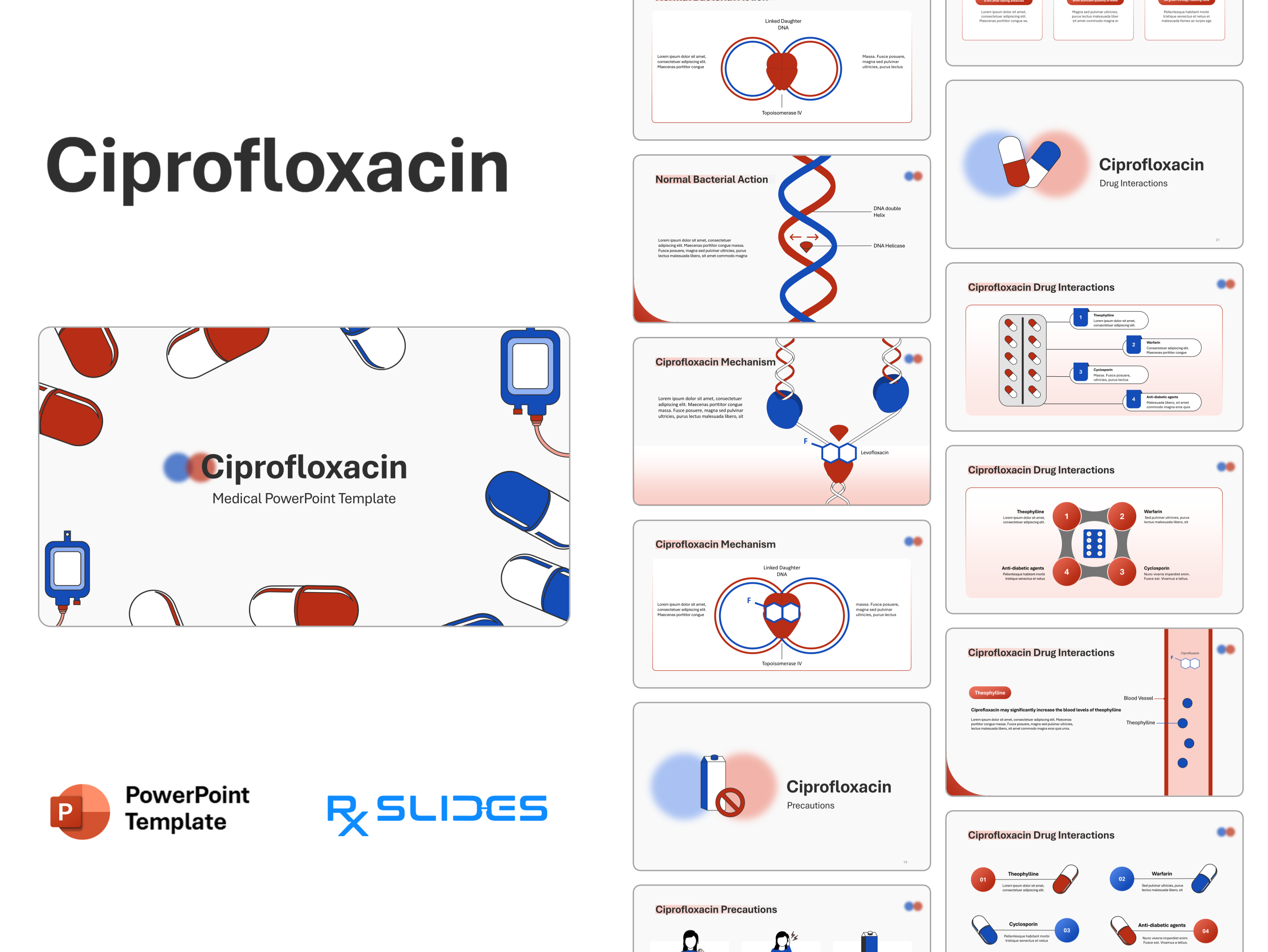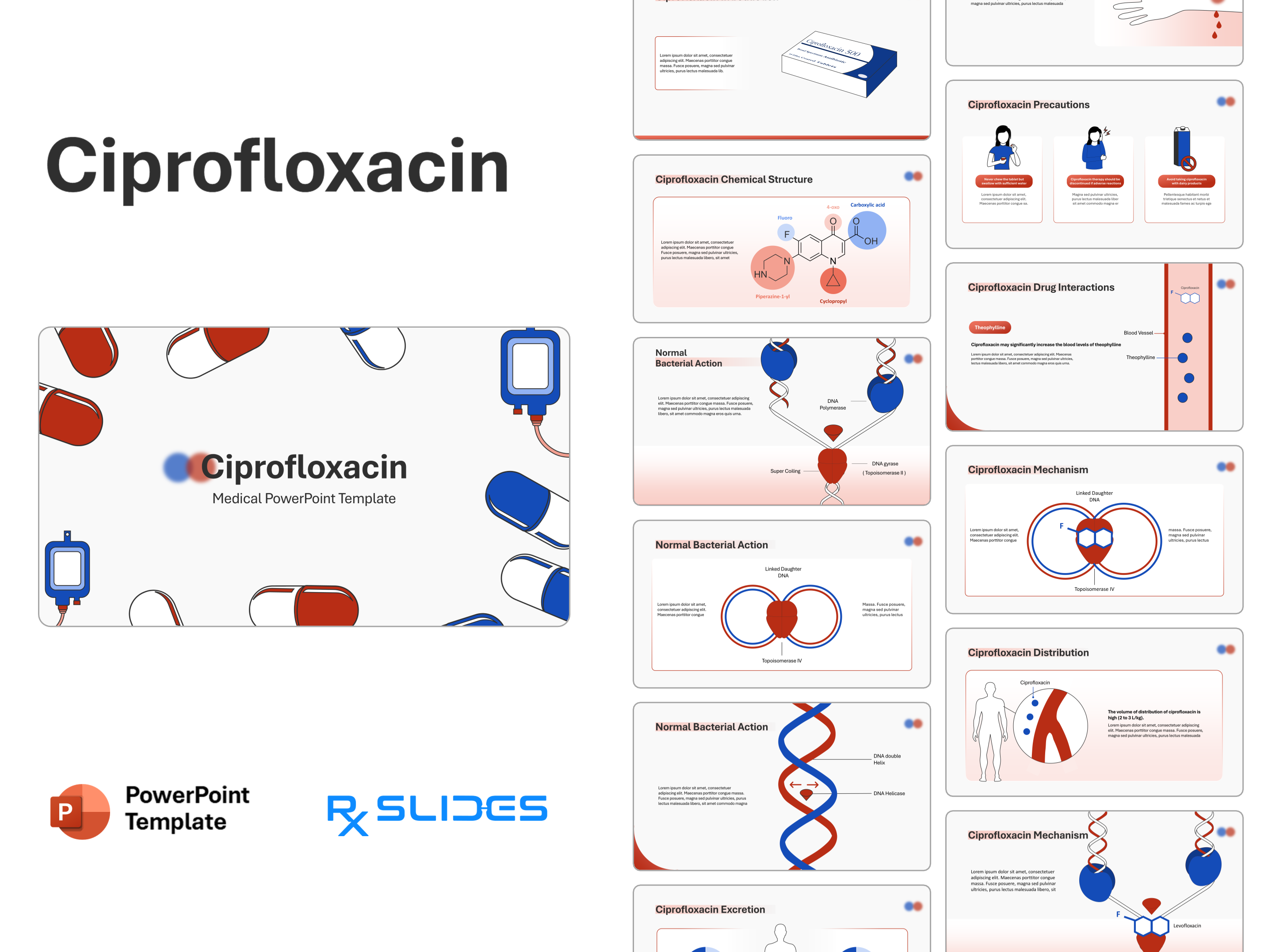Ciprofloxacin PowerPoint Template
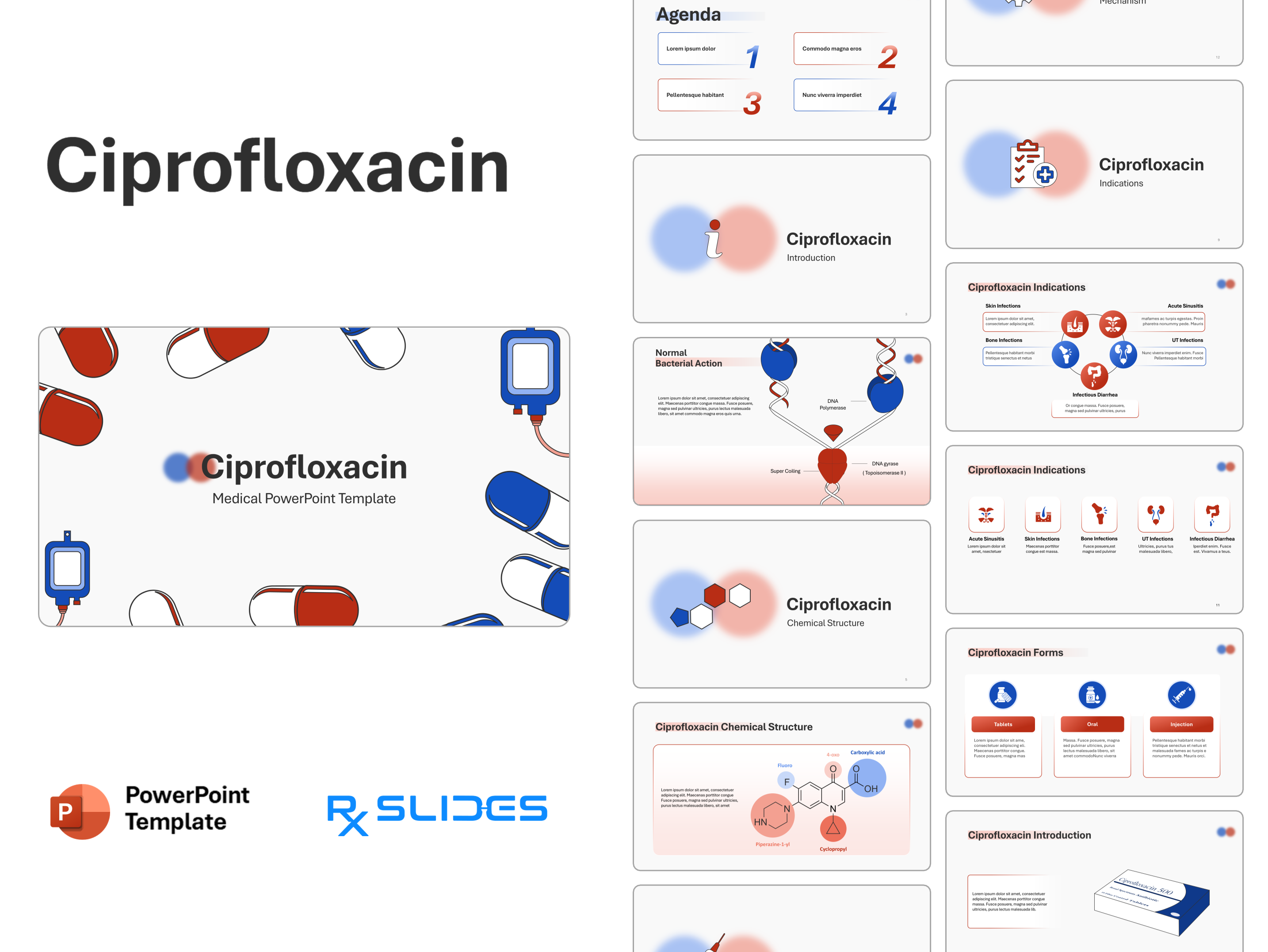
Ciprofloxacin PPT Template: Animated Medical PowerPoint
- Do you need help explaining ciprofloxacin mechanism of action clearly and engagingly?
- RxSlides introduces the ciprofloxacin PPT template—your animated solution!
- Imagine engaging your audience with impressive animations explaining how ciprofloxacin acts against bacteria.
- You can visualize the drug's journey as it targets and inhibits DNA replication, leaving a lasting impression with memoizable dynamics.
- The expertly developed template, designed by RxSlides medical professionals, ensures scientific accuracy and clear, concise language, is perfect for healthcare professionals and pharmaceutical marketing managers and is valuable for patient education.
Ciprofloxacin PPT Template Content
Slide 1 - Ciprofloxacin (Title Slide)
.PNG)
- Title slide featuring the medication name "Ciprofloxacin" prominently.
- The background uses a striking, stylized layout with repeating icons of capsules, pills, and IV bags, immediately establishing the topic as a detailed pharmacological or clinical drug presentation.
Slide 2 - Ciprofloxacin (Agenda)
.PNG)
- A clean, numbered agenda slide. Features four editable text boxes, numbered 1, 2, 3, and 4, using contrasting colors (red and blue) for visual interest.
- This slide is used to clearly outline the main sections of the pharmacological presentation, likely covering topics such as Mechanism of Action, Indications, Side Effects, and Dosing.
Slide 3 - Ciprofloxacin (Introduction Section Divider)
.PNG)
- Transitional slide introducing the Introduction section of the pharmacological presentation.
- Stylized information ('i') icon with red and blue background circles, setting the context for the initial, high-level overview of the drug.
Slide 4 - Ciprofloxacin Introduction (Drug Packaging)
.PNG)
- Definitional slide illustrating the drug product.
- a detailed, clean illustration of a Ciprofloxacin 500mg tablet box (labeled "Broad Spectrum Antibiotic" and "10 film Coated Tablets").
- Includes a framed, editable text box for detailing the drug's classification, history, or basic function as an introduction.
Slide 5 - Ciprofloxacin (Chemical Structure Section Divider)
.PNG)
- Transitional slide introducing the Chemical Structure section of the presentation.
- Features a stylized diagram of connected red, blue, and white hexagons, representing the molecular structure of the drug.
- This is ideal for discussing the pharmacology and mechanism of action based on its fluoroquinolone structure.
Slide 6 - Ciprofloxacin Chemical Structure (Detailed)
.PNG)
- Detailed slide featuring the complete chemical structure of Ciprofloxacin, a fluoroquinolone antibiotic.
- The structure is clearly annotated with colored circles and labels highlighting key functional groups: Fluoro, 4-oxo, Carboxylic acid, Cyclopropyl, and Piperazine-1-yl.
- This slide is essential for academic discussions on the drug's mechanism of action and resistance.
Slide 7 - Ciprofloxacin (Forms Section Divider)
.PNG)
- Transitional slide introducing the various Forms and Routes of Administration for Ciprofloxacin.
- Features a collection of stylized icons representing common drug formats: a syringe (injection/IV), a vial/bottle, and tablets/pills.
- This sets the stage for a discussion on dosing, administration, and pharmacokinetics.
Slide 8 - Ciprofloxacin Forms (Administration Routes)
.PNG)
- A three-column grid detailing the primary routes of administration for Ciprofloxacin. Each column features a distinct icon and a heading:
- Tablets: Icon showing blister pack and pills.
- Oral: Icon showing a vial with liquid/drops.
- Injection: Icon showing a syringe and needle.
- This slide is essential for conveying the versatility and clinical use cases for the medication in its various forms.
Slide 9 - Ciprofloxacin (Indications Section Divider)
.PNG)
- Transitional slide introducing the Indications (what the drug is used for) section of the presentation.
- Features a stylized icon of a checklist/clipboard with checkmarks combined with a medical cross, visually symbolizing prescribed use and effectiveness. This sets the stage for listing the bacterial infections treated by Ciprofloxacin.
Slide 10 - Ciprofloxacin Indications (Target Infections)
.PNG)
- Circular infographic detailing five key therapeutic uses for Ciprofloxacin, organized around distinct icons:
- Skin Infections (Icon of hair follicle/skin layers)
- Acute Sinusitis (Icon of nasal/sinus structures)
- UT Infections (Icon of kidneys/urinary system)
- Infectious Diarrhea (Icon of the lower GI tract)
- Bone Infections (Icon of bone/joint)
- This slide is crucial for explaining the drug's broad spectrum and its use in treating systemic infections across various body systems.
Slide 11 - Ciprofloxacin Indications (Icon Grid)
.PNG)
- A five-icon grid visually summarizing the major infection types treated by Ciprofloxacin. Each infection type is represented by a distinct, relevant icon:
- Acute Sinusitis (Sinus/Leaf icon)
- Skin Infections (Skin/Follicle icon)
- Bone Infections (Bone/Joint icon)
- UT Infections (Kidney/Urinary System icon)
- Infectious Diarrhea (Intestine/Lower GI icon)
This slide offers a quick, scannable overview of the drug's broad clinical utility.
Slide 12 - Ciprofloxacin (Mechanism Section Divider)
.PNG)
- Transitional slide introducing the Mechanism of Action (MoA) section.
- Features a stylized icon of interlocking gears in white, red, and blue, visually symbolizing the complex molecular and pharmacological processes involved in the drug's function.
Slide 13 - Ciprofloxacin (Normal Bacterial Action)
.PNG)
- Highly detailed diagram illustrating the Normal Bacterial Action of DNA replication, which Ciprofloxacin is designed to disrupt. The diagram clearly shows:
- The double helix of DNA undergoing Super Coiling.
- The role of the bacterial enzyme DNA Gyrase (Topoisomerase II) in managing supercoiling.
- The process involving DNA Polymerase.
This slide is essential as the baseline comparison for the next slide, which will illustrate Ciprofloxacin's mechanism of inhibition.
Slide 14 - Normal Bacterial Action (Alternate Diagram)
.PNG)
Simplified diagram illustrating the Normal Bacterial Action involving Topoisomerase IV during cell division. The diagram clearly shows:
- Two linked circular DNA strands (Linked Daughter DNA).
- The role of the enzyme Topoisomerase IV (represented by the red heart shape) in separating the linked daughter chromosomes.
This slide, along with Slide 13, establishes the two core enzymatic targets (DNA Gyrase and Topoisomerase IV) that Fluoroquinolones like Ciprofloxacin inhibit.
Slide 15 - Normal Bacterial Action (DNA Replication)
.PNG)
- Diagram illustrating a fundamental step in bacterial DNA replication. It clearly shows the DNA Double Helix and the enzyme DNA Helicase (represented by the red shape) responsible for unwinding the double helix for replication.
- This diagram serves to set the precise molecular stage for discussing how Ciprofloxacin inhibits the topoisomerase enzymes involved in this process.
Slide 16 - Ciprofloxacin Mechanism (Inhibition Diagram)
.PNG)
- Detailed diagram illustrating how Ciprofloxacin, a fluoroquinolone, inhibits bacterial DNA replication.
- The visual shows a molecular representation of the drug (or a related quinolone like Levofloxacin mentioned in the text area) interfering with the bacterial DNA structure (double helix) and the associated enzymes (represented by the large red and blue components).
- This confirms the inhibitory mechanism on DNA gyrase and/or topoisomerase IV.
Slide 17 - Normal Bacterial Action (Topoisomerase IV Focus)
.PNG)
- Diagram reiterating the essential function of Topoisomerase IV in bacterial cell division.
- It visually depicts two linked circular DNA strands (Linked Daughter DNA) that must be separated by Topoisomerase IV (the central red component) before the cell can fully divide.
- This serves as the second crucial molecular target inhibited by Ciprofloxacin and related fluoroquinolones.
Slide 18 - Ciprofloxacin (Precautions Section Divider)
.PNG)
- Transitional slide introducing the Precautions, Contraindications, and Drug Interactions section.
- Features a stylized icon of a common drug container (like a carton or bottle) overlaid with a red 'No' or prohibition sign, visually symbolizing safety warnings and limitations on use.
Slide 19 - Ciprofloxacin Precautions (Drug Interactions and Safety)
.PNG)
A three-column grid illustrating key patient precautions and drug interactions related to Ciprofloxacin therapy. Each column features a person icon and highlights a crucial instruction:
- Swallowing: Emphasizes taking the tablet with sufficient water (do not chew).
- Adverse Reactions: Shows a person holding their head (indicating side effects), stating that therapy should be discontinued if adverse reactions occur.
- Drug Interaction: Features a carton/bottle with a 'No' sign, warning to Avoid taking ciprofloxacin with dairy products (due to reduced absorption).
This slide is essential for patient counseling and safe prescribing practices.
Slide 20 - Ciprofloxacin Precautions (Administration Specifics)
.PNG)
A three-column grid detailing specific administration rules and drug-timing precautions for Ciprofloxacin therapy. Each column highlights a crucial instruction with relevant icons:
- Antacids: Features a pill bottle and pills, warning that Ciprofloxacin "Should be taken 2 hrs before or 6 hrs after taking antacids" (due to chelation and absorption issues).
- Hydration: Features a bottle and glass, advising "Patients should be informed to drink sufficient quantity of water" (to prevent crystalluria).
- Suspension: Features a spoon and medication bottle, advising "Oral suspension should never be given through feeding tube" (due to caking/clogging risk).
This slide is vital for safe and effective drug delivery.
Slide 21 - Ciprofloxacin (Drug Interactions Section Divider)
.PNG)
- Transitional slide introducing the Drug Interactions section. Features a stylized icon of two overlapping capsules (one red and one blue/white), visually representing the potential complexity or conflicts when Ciprofloxacin is taken alongside other medications.
Slide 22 - Ciprofloxacin Drug Interactions (Key Medications)
.PNG)
A detailed four-point chart illustrating major drug-drug interactions with Ciprofloxacin. The visual centerpiece is a blister pack of pills, with numbered lines pointing to editable text boxes for detailing the interaction with:
- Theophylline
- Warfarin
- Cyclosporin
- Anti-diabetic agents
This slide is crucial for physicians and pharmacists to understand prescribing risks.
Slide 23 - Ciprofloxacin Drug Interactions (Circular Infographic)
.PNG)
- A circular, four-point infographic detailing the key drug-drug interactions with Ciprofloxacin.
- The visual centerpiece is a blister pack icon, surrounded by four interconnected circles that label the interacting medications
Slide 24 - Ciprofloxacin Drug Interactions (Four-Point Capsule Layout)
.PNG)
- A four-point infographic using a horizontal flow with capsule icons to detail major drug-drug interactions with Ciprofloxacin. Each interaction is clearly numbered and paired with a capsule icon
Slide 25 - Ciprofloxacin Drug Interactions (Theophylline Detail)
.PNG)
- A detailed slide focusing on the interaction between Ciprofloxacin and Theophylline.
- The visual illustrates the drugs and the blood vessel, stating the key danger: "Ciprofloxacin may significantly increase the blood levels of theophylline".
- The diagram visually represents Ciprofloxacin's molecular structure and the presence of Theophylline within the Blood Vessel.
Slide 26 - Ciprofloxacin Drug Interactions (Warfarin Detail)
.PNG)
- A detailed slide focusing on the interaction between Ciprofloxacin and Warfarin.
- The visual shows a stylized hand with an incision and dripping blood, stating the key warning: "Using ciprofloxacin together with warfarin may cause you to bleed more easily".
- The diagram visually includes the Ciprofloxacin molecular structure. This highlights the potential for Ciprofloxacin to potentiate the anticoagulant effect of Warfarin.
Slide 27 - Ciprofloxacin Drug Interactions (Cyclosporin Detail)
.PNG)
- A detailed slide focusing on the interaction between Ciprofloxacin and Cyclosporin.
- The key warning is that "Using ciprofloxacin together with cyclosporine can increase the effects of cyclosporine".
- The visual shows the Ciprofloxacin molecular structure, along with multiple representations of the Cyclosporin molecule.
- This highlights the clinical risk of elevated Cyclosporin levels.
Slide 28 - Ciprofloxacin Drug Interactions (Anti-diabetic Agents Detail)
.PNG)
- A detailed slide focusing on the interaction between Ciprofloxacin and Anti-diabetic agents.
- The slide features a prominent illustration of a blood glucose meter (displaying a reading of 104) with a blood drop.
- The accompanying text warns that Ciprofloxacin can sometimes affect blood glucose levels, reporting both hyperglycemia (high blood glucose) and, less frequently, hypoglycemia (low blood glucose).
Slide 29 - Ciprofloxacin (Pharmacokinetics Section Divider)
.PNG)
- Transitional slide introducing the Pharmacokinetics section, which covers drug absorption, distribution, metabolism, and excretion (ADME).
- Features a stylized human figure with internal components, bar charts (for distribution/elimination rates), and pie charts (for metabolism/percentage), visually representing the systemic activity of the drug within the body.
Slide 30 - Ciprofloxacin Pharmacokinetics (ADME Diagram)
.PNG)
A detailed infographic outlining the four key stages of Pharmacokinetics (ADME) within the human body.
The visual centerpiece is a stylized human silhouette with the digestive tract highlighted in blue, surrounded by four distinct, numbered sections:
- Absorption: Describes how the drug enters the bloodstream.
- Distribution: Describes where the drug goes in the body.
- Metabolism: Describes how the drug is chemically altered (often in the liver).
- Excretion: Describes how the drug is eliminated from the body.
This slide provides a complete overview of the drug's journey through the body.
Slide 31 - Ciprofloxacin Absorption (Bioavailability & Interactions)
.PNG)
A detailed slide focusing on the Absorption component of pharmacokinetics.
The central image is a human silhouette with three key data points linked visually:
- Bioavailability: Indicated by a pie chart, stating the bioavailability of oral Ciprofloxacin is 70 to 80%.
- Peak Time (Tmax): Indicated by a clock icon, stating the time to peak concentrations after oral administration is 1 to 1.5 h.
- Interaction Warning: Indicated by a bottle/glass with an 'X', warning to Avoid concurrent administration of ciprofloxacin with dairy products or calcium-fortified juices due to decreased absorption.
This slide provides critical information on the drug's oral efficacy and necessary administration precautions.
Slide 32 - Ciprofloxacin Distribution
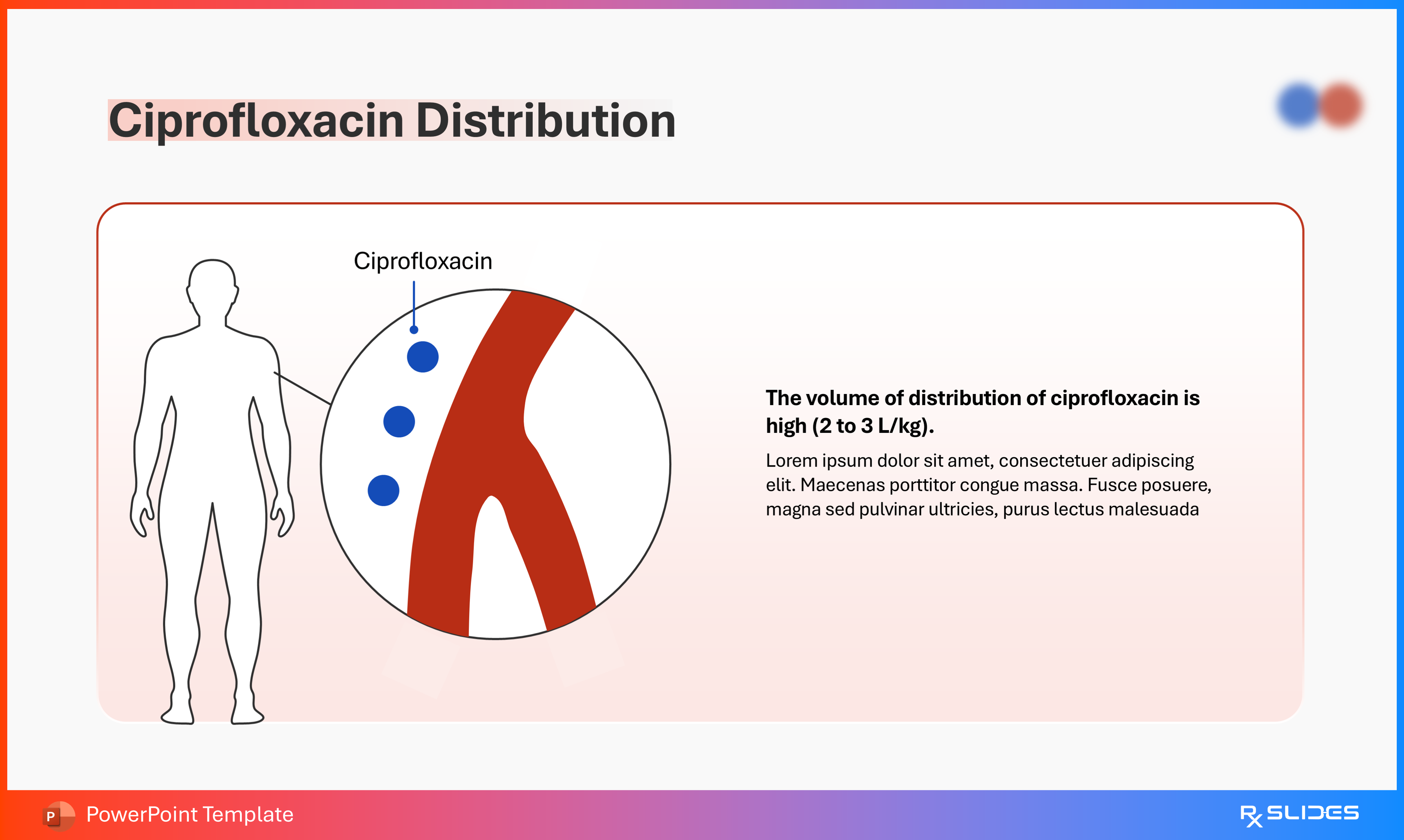
- A detailed slide focusing on the Distribution component of pharmacokinetics.
- The visual centerpiece is a human silhouette with a magnified circle illustrating a blood vessel and Ciprofloxacin particles (blue circles).
- The key text highlights the drug's high distribution: "The volume of distribution of ciprofloxacin is high (2 to 3 L/kg)".
- This information is Important for understanding tissue penetration and drug efficacy.
Slide 33 - Ciprofloxacin Metabolism
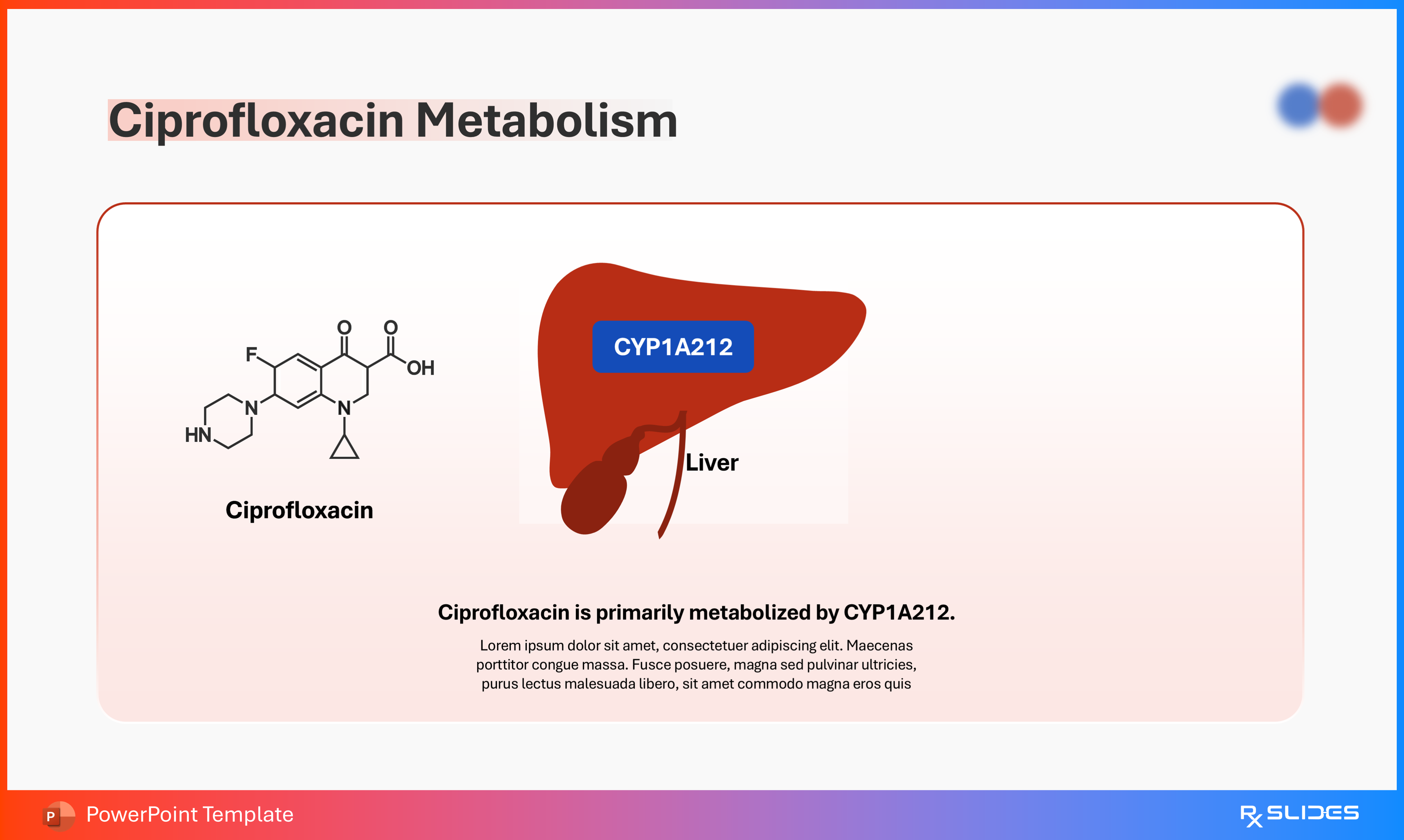
- A detailed slide focusing on the Metabolism component of pharmacokinetics.
- The visual centerpiece includes the Ciprofloxacin chemical structure alongside a diagram of the Liver.
- The key text confirms: "Ciprofloxacin is primarily metabolized by CYP1A2" (a Cytochrome P450 enzyme, explicitly labeled in the diagram as CYP1A212 or similar).
- This slide is critical for understanding drug clearance and potential drug interactions related to enzyme induction/inhibition.
Slide 34 - Ciprofloxacin Excretion
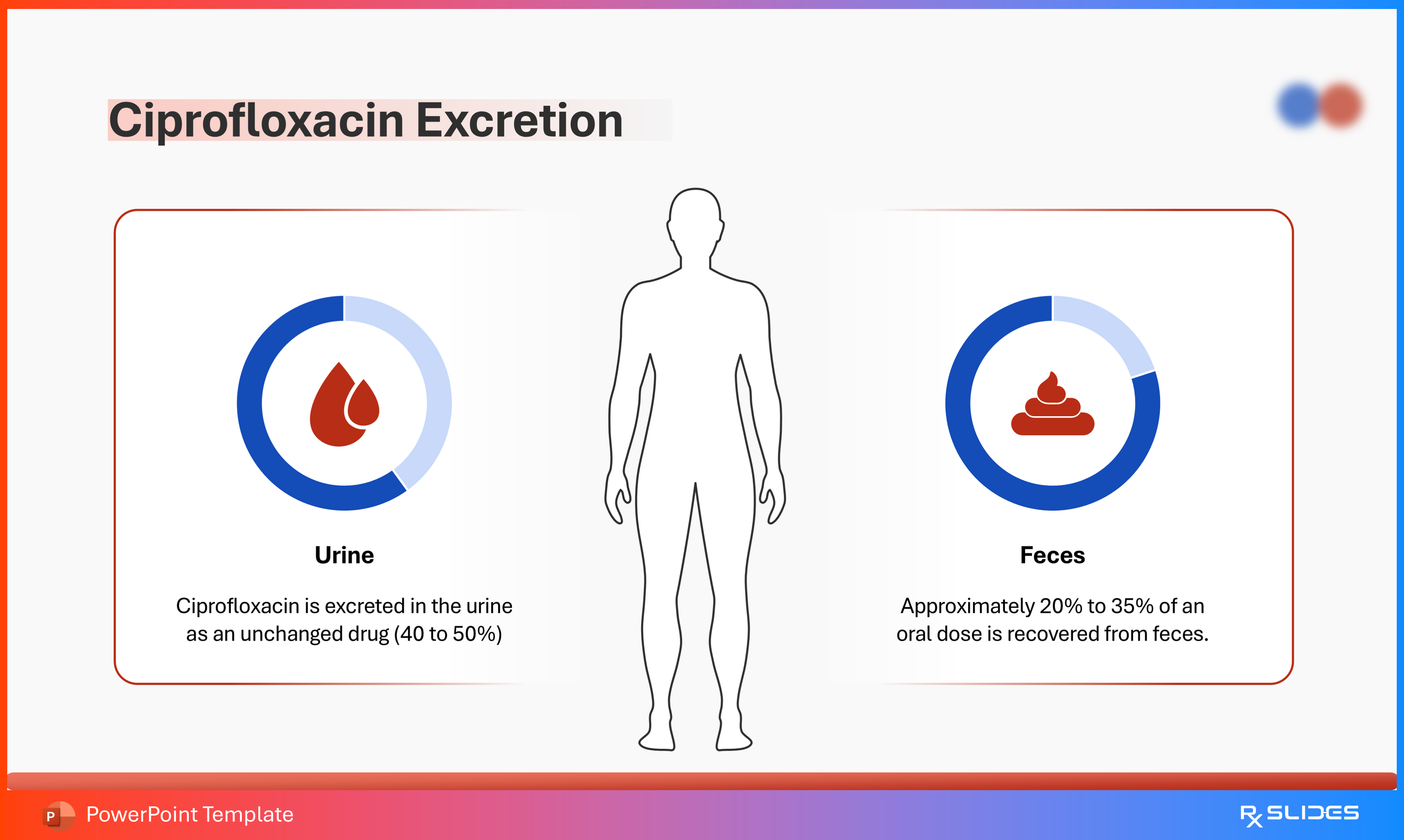
A detailed slide focusing on the Excretion (elimination) component of pharmacokinetics. The visual features a human silhouette positioned between two circular charts detailing the excretion routes:
- Urine: Pie chart with a blood/fluid drop icon, stating: "Ciprofloxacin is excreted in the urine as an unchanged drug (40 to 50%)".
- Feces: Pie chart with a feces icon, stating: "Approximately 20% to 35% of an oral dose is recovered from feces".
This slide provides comprehensive data on drug clearance, which is important for adjusting doses in patients with renal impairment.
Slide 35 - Half-life of Ciprofloxacin (Age Comparison)
.PNG)
A side-by-side comparative slide featuring two separate time vs. concentration (nmol/L) decay graphs, highlighting the difference in drug elimination between patient demographics:
- Old People: Graph shows a slower elimination curve. Text notes the elimination half-life ranges from 3.3 to 6.8 hours in the elderly.
- Young People: Graph shows a faster elimination curve. Text notes the elimination half-life ranges from 3 to 4 hours in younger persons.
This slide is essential for demonstrating the need for potential dosage adjustment in geriatric patients.
Slide 36 - Ciprofloxacin (Adverse Reactions Section Divider)
.PNG)
- Transitional slide introducing the Adverse Reactions (Side Effects) section of the pharmacological presentation.
- Features a stylized icon of an exclamation point within a warning triangle paired with a capsule, visually signaling potential patient side effects and safety considerations.
Slide 37 - Ciprofloxacin Adverse Reactions (Common Side Effects)
.PNG)
A detailed infographic outlining seven common adverse reactions (side effects) associated with Ciprofloxacin therapy, organized with clear icons:
- Dizziness (Icon of person with spinning head effect)
- Headache (Icon of person with lightning bolts at the head)
- Diarrhea (Icon of person with lower GI issues)
- Upset Stomach (Icon of stomach/upper GI tract)
- Muscles Weakness (Icon of leg/muscle with pain)
- Tendon Rupture (Icon of ankle/foot, referencing the serious fluoroquinolone black box warning)
This slide is essential for patient education and risk assessment during treatment.
Slide 38 - Ciprofloxacin Adverse Reactions (Three-Point List)
.PNG)
A three-column grid detailing the most common adverse reactions, providing editable text boxes below the icons:
- Dizziness (Icon of person with spinning head effect)
- Headache (Icon of person with lightning bolts at the head)
- Upset Stomach (Icon of stomach/upper GI tract)
This slide provides a focused summary of three frequently reported side effects.
Slide 39 - Ciprofloxacin Adverse Reactions (Three-Point List Continued)
.PNG)
A three-column grid continuing the list of adverse reactions, providing editable text boxes below the icons:
- Muscles Weakness (Icon of muscle with pain/lightning bolts)
- Diarrhea (Icon of lower GI tract issues)
- Tendon rupture (Icon of ankle/foot)
This slide completes the overview of key side effects, notably including the severe warning regarding Tendon rupture associated with fluoroquinolones.
Slide 40 - Thank You (Closing Slide)
.PNG)
- The final closing slide of the presentation. It features the text "Thank you" prominently alongside stylized icons of a syringe, a vial, and pills, visually summarizing the pharmaceutical and clinical nature of the presentation.
- This provides a clean, professional conclusion to the pharmacological review.
Features of the Template
- 100% editable PowerPoint template.
- Editable colors, you can change according to your presentation style and company branding guidelines.

